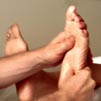|
|
 What is massage therapy? What is massage therapy?
Massage therapy spans a wide variety of therapeutic approaches, working to improve an individual's health and well-being through the hands-on manipulation of muscles and soft tissue.
What are the key benefits of massage therapy?
Physical -- Massage therapy is designed to stretch and loosen muscles, improve blood flow and the movement of lymph throughout the body, facilitate the removal of metabolic wastes resulting from exercise or inactivity, and increase the flow of oxygen and nutrients to cells and tissue. In addition, massage stimulates the release of endorphins -- the body's natural painkiller -- into the brain and nervous system.
Mental -- Massage therapy provides a relaxed state of alertness, reduces mental stress and enhances capacity for calm thinking and creativity.
Emotional -- Massage therapy satisfies the need for caring and nurturing touch, creates a
feeling of well-being and reduces anxiety levels.
Who can benefit from massage therapy?
People throughout the life cycle -- from the very young and very old to those in between -- all find that a professional massage can have special applications suited for their needs.
What is the origin of therapeutic massage?
Therapeutic massage methods used today have both Eastern and Western origins. The first written records of massage date back 3,000 years to early Chinese folk medicine and ancient Ayurvedic medicine of India. Shiatsu, acupressure and reflexology spring from these Eastern sources, as do other contemporary methods.
Western civilizations were introduced to therapeutic massage by Greek and Roman physicians. Modern Western massage is credited primarily to Peter Henrik Ling, a 19th century Swedish athlete. His approach, which combines hands-on techniques with active and passive movements, became known as Swedish massage -- still one of the most commonly used methods in the Western world.
What do research studies say about massage therapy?
A myriad of research studies confirm that massage therapy provides physical, mental and emotional
benefits at all stages of life.
How is massage therapy regarded by the medical community?
The results of a survey conducted between November 2000 and February 2001 in Washington State,
indicate strong recognition on the part of medical clinicians that massage therapy is effective. In
Washington, where complementary and alternative medicine (CAM) providers have been recognized by
health plans since 1996, the survey asked medical practitioners five years later what they thought of CAM
practices. Of 12 CAM practices included in the survey, massage therapy was ranked highest (74%) in terms
of being perceived as always or usually effective. The next closest CAM practice in the same category of
effectiveness was acupuncture, ranked by 67.7% of clinician respondents.1
How popular is massage therapy as a form of medical treatment?
When naming the types of alternative care consumers say they would be most likely to use, 80% say massage therapy.
Is massage therapy a luxury?
This is a perception that is rapidly changing as massage becomes increasingly accepted as a natural part of a healthy lifestyle. In fact, according to one media characterization, "massage is to the human body what a tune-up is to a car. It provides a physical boost to the weary, sore and stressed."
An increasing body of clinical research confirms that massage reduces heart rate, lowers blood pressure, increases blood circulation and lymph flow, relaxes muscles, improves range of motion, boosts the immune system, and increases endorphins (all may enhance medical treatment).
What is the average cost of a massage?
Cost depends upon the type of treatment, the experience of the practitioner, geographic location and length of the massage. Nationally, the range is generally from $45 to $80 for an hour-long treatment, with home visits sometimes more expensive.
What credentials should a qualified massage therapist have?
The therapist should be licensed or certified, depending on the laws of your state or local government.
Thirty-three states and the District of Columbia have passed legislation to regulate the massage therapy
profession. The therapist should also be insured with professional liability insurance.
A massage therapist should be able to document professional training in massage therapy at a massage training institution such as those accredited by the Commission on Massage Therapy Accreditation (COMTA) or is a member of the AMTA Council of Schools. He/she should be a member of a professional association with high standards for membership and/or be Nationally Certified in Therapeutic Massage and Bodywork (NCTMB).
COMTA-accredited massage training programs require a stringent course of study, including at least 500 hours of classroom instruction in anatomy and physiology, massage and technique, relationships with clients, plus related subjects. AMTA Professional membership is limited to massage therapists who have demonstrated a level of skill and expertise through testing and/or education. In addition, all AMTA-member therapists must agree to abide by the AMTA Code of Ethics.
How many massage therapists are there in the U.S.?
The number of massage therapists is estimated at between 260,000 and 290,000, including part-time and full-time practitioners, and students.
Where do massage therapists practice?
Massage therapists offer their services in a wide variety of settings, including:
- private practice clinics and offices
- physicians' offices and wellness facilities
- chiropractors' offices and rehabilitation clinics
- salons, spas, resorts and cruise ships
- health clubs and fitness centers
- nursing homes and hospitals
- on-site in the workplace
- in client's homes
How can I find a qualified massage therapist?
AMTA's Find a Massage Therapist national locator service can help people locate a qualified massage therapist nearby. This free service is available via the Web at www.amtamassage.org and toll-free at 888-843-2682. Personal referrals from friends or healthcare providers are another way to find a massage therapist.
When calling therapists, ask what services they offer, inquire about their training and/or National Certification, and ask for references. Personality fit also is important in choosing a massage therapist, as is trust, and feeling confident in and comfortable with the massage therapist. Massage therapists use a variety of techniques. You may need to try a few different practitioners to find one that fits your needs.
Is massage therapy a growing profession?
Yes, according to many indicators. For example:
- AMTA's membership quadrupled in the 1990s to more than 41,000. By June 2001, AMTA's membership had grown to approximately 47,000.
- With an increasing emphasis on preventive care, health insurers are beginning to extend coverage in some plans to include the practice of massage therapy.
- Consumer demand for massage from massage therapists continues to grow. Between 1997 and 2000, the number of American adults who reported getting a massage from a massage therapist in the previous year doubled, from 8% to 16%.5
What is fueling the growth of massage therapy?
The health and fitness movement also is a driving force behind the growth of the massage therapy profession, is America's growing emphasis on wellness, and the aging of the "Baby-boomer" population.
When might the use of massage therapy be inappropriate?
If you suffer from certain circulatory ailments (such as phlebitis), infectious diseases, certain forms of cancer, cardiac problems, certain skin conditions, or any inflamed or infected tissues. Be sure to consult your physician before initiating any massage program. A trained and experienced massage therapist will also be able to tell you when massage is not indicated.
What should consumers expect when they receive a massage for the first time?
At first contact, the massage therapist should ask about your reasons for getting a massage, current physical condition, medical history, lifestyle and stress level, and specific areas of pain. If necessary, undressing takes place in private and a sheet, towel or gown is provided for draping during the massage. The therapist will undrape only the part of the body being massaged, ensuring that modesty is respected at all times. The massage takes place on a comfortable padded surface.
Does the consumer have any responsibilities during the massage?
A person receiving a massage should give the therapist accurate health information and always report discomfort of any kind -- whether it's from the massage itself or due to room temperature, volume of music, or other distractions.
|  |